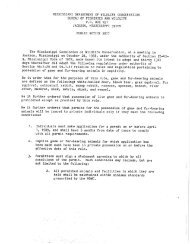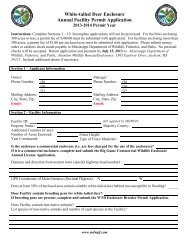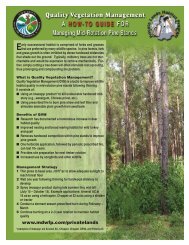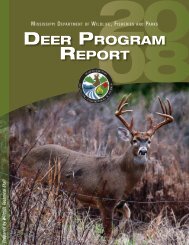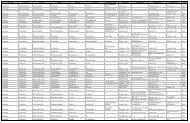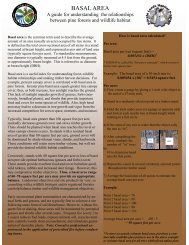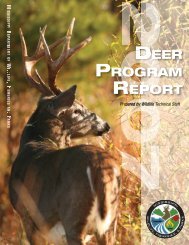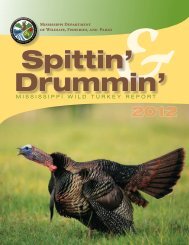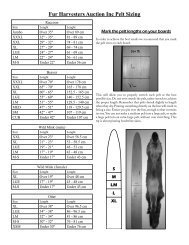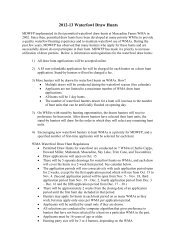Pine Forestland Habitat Management for Wildlife - Forest and ...
Pine Forestland Habitat Management for Wildlife - Forest and ...
Pine Forestland Habitat Management for Wildlife - Forest and ...
- No tags were found...
Create successful ePaper yourself
Turn your PDF publications into a flip-book with our unique Google optimized e-Paper software.
Reducing tree density is the first step indeveloping the grass <strong>and</strong> <strong>for</strong>b groundcover so valuable to quail <strong>and</strong> othergrassl<strong>and</strong> species. Thinning reduces stemdensity <strong>and</strong> opens the <strong>for</strong>est canopy,allowing more sunlight to reach theground <strong>and</strong> stimulating growth of groundlayervegetation. In Mississippi, mostspecies of pines can be commerciallythinned <strong>for</strong> the first time at 13-18 yearsof age, depending on the site. Typicaltimber thins reduce basal area to about70 ft 2 /acre, but thinning st<strong>and</strong>s to a basalarea of 60 ft 2 /acre or less produces bettergrassl<strong>and</strong> wildlife habitat. If grassl<strong>and</strong>wildlife habitat is a greater priority thantimber production, a basal area as lowas 30 ft 2 /acre will produce optimalhabitat. It may be desirable to thin lessheavily during the first thinning, as treesmay be more vulnerable to ice or winddamage. Subsequent thins can then beused to reduce basal area to 60 ft 2 /acreor less. Periodic thins will be necessaryto maintain lower basal areas as treescontinue to grow after each thinning.Individual l<strong>and</strong>owner objectives will vary,so consultation with a registered <strong>for</strong>ester<strong>and</strong> a wildlife biologist can help you findthe best balance that meets both yourwildlife <strong>and</strong> timber objectives.<strong>Pine</strong> plantation thinned along every fifth row.Notice the increased sunlight that is visible alongthe thinned row.
Prescribed fire in pineJust as thinning stimulates growthof grasses <strong>and</strong> <strong>for</strong>bs, it also releasesunderstory hardwood brush <strong>and</strong> treesthat will shade out desirable grasses <strong>and</strong><strong>for</strong>bs if left unmanaged. Some <strong>for</strong>m ofperiodic disturbance will be necessary tocontrol brush invasion. Prescribed fire<strong>and</strong> disking are two disturbance tools.When fuel conditions are appropriate <strong>for</strong>burning, thinned pine st<strong>and</strong>s should beprescribe-burned during winter to earlyspring.Prescribed burning should alwaysbe conducted by a certified prescribedburn manager, who will develop a writtenburn plan <strong>and</strong> obtain appropriate permitsbe<strong>for</strong>e burning. Check with your countyMississippi <strong>Forest</strong>ry Commission office<strong>for</strong> more in<strong>for</strong>mation about prescribedburning regulations. If prescribed fireis not an option, light disking betweenthinned trees during fall or winter isan alternative <strong>for</strong> relatively clean sites.Always be especially cautious whendisking in woodl<strong>and</strong>s to avoid damagingtree trunks <strong>and</strong> roots <strong>and</strong> to avoidpersonal injury or equipment damage.Soil disturbance, such as prescribed fireor disking, enhances habitat quality <strong>for</strong>quail <strong>and</strong> other grassl<strong>and</strong> birds because itinhibits woody brush growth, promotesfavored seed producing plants, reducesplant residue, increases bare ground, <strong>and</strong>increases insect abundance. The plantcommunities that develop following fireor disking also provide highly nutritious<strong>for</strong>age <strong>for</strong> deer, rabbits, turkeys, <strong>and</strong>Thinned pine st<strong>and</strong> with grass/<strong>for</strong>bunderstory after prescribed fireother wildlife. In the absence of soildisturbance, the plant communitycomposition changes over severalyears, <strong>and</strong> annual plants are replacedby perennial <strong>for</strong>bs <strong>and</strong> grasses <strong>and</strong>eventually, woody plants. This change inplant communities is called succession.By planning soil disturbances on a2– to 3–year rotation, you can managesuccession <strong>and</strong> develop a complex ofdifferent habitats that meet the seasonalhabitat requirements of a number ofwildlife species. For example, first-yearburn areas typically produce good quailbrood cover, whereas second- <strong>and</strong> thirdyearburn areas provide better nestingcover. A rotational burning plan can bedeveloped by creating 60-acre or smallerburn units <strong>and</strong> burning half to a thirdof these units one year, another half toa third the next year, <strong>and</strong> so on. Thus,a given unit is only burned every 2-3years, but some portion of the propertyis burned each year. A rotational diskingplan can be developed similarly. Disk ahalf to a third of suitable area each yearin a rotational fashion so that all suitableareas are disked every 2-3 years.
<strong>Pine</strong> st<strong>and</strong> invaded by hardwood brush (left)compared to a pine st<strong>and</strong> treated with selectiveherbicide (right). Notice the grass/<strong>for</strong>b understorypresent in the herbicide treated st<strong>and</strong>.Often, fire has been excluded from pinest<strong>and</strong>s <strong>for</strong> so long that invasive hardwoodspecies can no longer be controlled bylow-intensity prescribed fires or disking.After thinning, if hardwood sprouts areabundant in the understory or midstory,it may be necessary to treat these st<strong>and</strong>swith a selective herbicide such as imazapyr(e.g. Arsenal AC®). Chemical controlof invasive hardwoods is enhanced whenprescribed fire is used during the dormantseason following herbicide application(wait at least 6 months after applicationbe<strong>for</strong>e burning to maximize herbicideeffectiveness). Once these hardwoodspecies are controlled with herbicide,future fire or disking treatments on a 2-to 3-year rotation should provide bettercontrol of hardwood invasions. Withsome planning, you can protect somemast/fruit producing hardwoods <strong>and</strong>shrubs from prescribed fire <strong>and</strong> herbicidetreatments. These scattered hard <strong>and</strong>soft mast producing trees <strong>and</strong> shrubscan provide food <strong>and</strong> cover resources<strong>for</strong> a diversity of wildlife. Invasive,non-native vegetation (e.g. kudzu,cogongrass) should also be controlledby herbicide treatment. Cogongrass,especially, is extremely invasive <strong>and</strong>seriously detrimental to native plants<strong>and</strong> wildlife habitat. Herbicidal controlof all types of invasive vegetation will bemore economical <strong>and</strong> effective if invasivespecies are treated when they first appear.Contact a <strong>for</strong>ester or wildlife biologistto develop a plan <strong>for</strong> controlling invasivevegetation.
A good way to produce more grassl<strong>and</strong>wildlife habitat in <strong>for</strong>estl<strong>and</strong> is to create<strong>for</strong>est openings. For quail, 10% ormore of <strong>for</strong>ested acreage should bemaintained in openings. These can becreated in established woodl<strong>and</strong>s by clearcutting 1– to 5–acre patches throughout<strong>for</strong>est st<strong>and</strong>s. Openings can easily becreated during commercial thinningof pine st<strong>and</strong>s. Plan ahead <strong>and</strong> haveyour <strong>for</strong>ester mark out <strong>for</strong>est openingswhen marking timber <strong>for</strong> thinning. Formid-rotation pine plantations, a betterapproach to developing openings is tocreate interconnected <strong>for</strong>est openingsin a hub-<strong>and</strong>-spoke design. The hub<strong>and</strong>-spokeopening consists of a centralopening (hub) from which open lanes(spokes) radiate through the pine st<strong>and</strong>as if simulating a wagon wheel. Hub<strong>and</strong>-spokeopenings can be created byremoving several adjacent rows of treesduring thinning of a pine plantation. Hub<strong>and</strong>-spokelanes should be at least 30 feetwide to maintain grassy cover, <strong>and</strong> themaximum width of lanes will depend onhow much timber acreage you are willingto remove from production (generally, thewider the lanes, the better). Hub-<strong>and</strong>spokescan also be used as fire breaks<strong>for</strong> prescribed burning of mid-rotationpine st<strong>and</strong>s. <strong>Forest</strong> openings can also bedeveloped by widening or heavily thinningwoodl<strong>and</strong> roadsides <strong>and</strong> maintaining logdecksor skid trails used during timberharvests. <strong>Forest</strong> openings may also beused <strong>for</strong> permanent or rotational foodplots planted to appropriate supplementalfood crops <strong>and</strong> log-decks during timberharvests. Prescribed fire or diskingon a 2- to 3-year rotation (describedabove) should be used to manage <strong>for</strong>estopenings.Aerial view of a hub-<strong>and</strong>-spoke <strong>for</strong>est opening.
Longleaf (left) <strong>and</strong> loblolly (right) pinesplanted at the same time <strong>and</strong> same seedlingdensity (about 600 trees per acre). Noticehow much more open the longleaf pinecanopy is than the loblolly pine canopy.As in established st<strong>and</strong>s, a good wayto produce grassl<strong>and</strong> wildlife habitat inregenerated <strong>for</strong>est st<strong>and</strong>s is to create<strong>for</strong>est openings. You can create <strong>for</strong>estopenings by simply leaving some welldistributed 1– to 5–acre unplantedpatches of l<strong>and</strong> when regenerating withplanted seedlings. A better approach todeveloping openings in pine plantationsis to create interconnected openingsin a hub-<strong>and</strong>-spoke design. With thehub <strong>and</strong> spoke design, grassl<strong>and</strong> habitatcorridors can be maintained throughoutthe st<strong>and</strong> after the <strong>for</strong>est canopy closes.Without interconnecting <strong>for</strong>est openings,grassy openings within young pineplantations will become isolated <strong>and</strong>generally unusable <strong>for</strong> quail as the pinecanopy closes. Hub-<strong>and</strong>-spoke openingscan also serve as fire breaks to protectyoung plantations from wild fire <strong>and</strong> <strong>for</strong>prescribed burning in later years. Theseopenings are also useful <strong>for</strong> log-decksduring future timber harvests.
Converting <strong>for</strong>mer agricultural fieldsor pastures to pine <strong>for</strong>estl<strong>and</strong> <strong>and</strong>managing <strong>for</strong> grassl<strong>and</strong> wildlife habitat isaccomplished in the same general way asregeneration of recently harvested <strong>for</strong>ests.However, pine plantings at these sitesshould be preceded by site preparationto control herbaceous competition. Thisis especially true when sod-<strong>for</strong>ming, nonnativegrasses are present at the plantingsite. The most common of these invasive,non-native grasses include fescue,bahiagrass, bermudagrass, johnsongrass,<strong>and</strong> cogongrass. Both cogongrass <strong>and</strong>bermudagrass are extremely invasive <strong>and</strong>seriously detrimental to native plants<strong>and</strong> wildlife habitat. These non-nativegrasses provide poor wildlife habitat <strong>and</strong>compete with growing seedling trees.Longleaf pine seedlings are especiallysensitive to competition with invasive,non-native grasses. Eradication of thesegrasses will significantly improve longleafseedling survival. Non-native grassesshould be eradicated with an appropriateherbicide treatment, but the appropriatetreatment differs depending on whichnon-native grass or grasses are present.Consult with your <strong>for</strong>ester to develop anappropriate herbicide prescription <strong>for</strong>pine establishment in <strong>for</strong>mer agriculturalfields. Once invasive grasses arecontrolled, these sites can be managedas recommended <strong>for</strong> <strong>for</strong>est regenerationsites. <strong>Wildlife</strong> habitat in these old fieldpine plantings may be further enhanced byplanting native grasses <strong>and</strong> <strong>for</strong>bs betweenseedling rows after non-native grasseshave been eliminated.Longleaf pine seedling in an old bahiagrasspasture. <strong>Habitat</strong> in this <strong>for</strong>mer pasturecould be improved by eradicating bahiagrass<strong>and</strong> allowing native grasses <strong>and</strong> <strong>for</strong>bs torecolonize the site.Longleaf pine planted in an old field
Developing an integrated <strong>for</strong>est-wildlifemanagement plan with a wildlife biologist<strong>and</strong> a registered <strong>for</strong>ester can providevaluable assistance in the implementationof these practices <strong>for</strong> both wildlife habitat<strong>and</strong> timber management. A number ofcost-share programs exist that can helpwith implementation costs associated with<strong>for</strong>est management practices. In order tosuccessfully achieve management goals,clearly established objectives (<strong>for</strong>estwildlifemanagement plan) should be inplace be<strong>for</strong>e consulting with agenciesthat administer cost-share programs. Byplanning ahead, programs <strong>and</strong> practicesthat accomplish management objectives<strong>and</strong> are financially sound may be selected.Following is a brief summary of financialassistance programs available <strong>for</strong> privatel<strong>and</strong>owners.The Conservation Reserve Program(CRP), Environmental Quality IncentivesProgram (EQIP), <strong>and</strong> ConservationSecurity Program (CSP) are available<strong>for</strong> l<strong>and</strong>owners with eligible productionagriculture l<strong>and</strong>. CRP providesconservation practices <strong>for</strong> field-levelmanagement, whereas EQIP <strong>and</strong> CSPare more oriented toward wholefarmmanagement. While many of thesame goals can be accomplished witheach program, there are differences ineligibility <strong>and</strong> financial incentives under
each program. If acreage is enrolledin an existing CRP pine woodl<strong>and</strong>conservation cover, mid-contractmanagement cost-shares are available <strong>for</strong>prescribed fire, herbicide application,<strong>and</strong> disking. Contact the countyU.S.D.A. Farm Service Agency office<strong>for</strong> more in<strong>for</strong>mation regarding CRP. Ifa whole-farm management program isapplicable to the property, contact thecounty U.S.D.A. Natural ResourcesConservation Service (NRCS) office <strong>for</strong>more in<strong>for</strong>mation on EQIP or CSP. <strong>Forest</strong>management practices available throughEQIP will depend on the county in whichthe property is located. Depending onl<strong>and</strong> uses, multiple farm programs maybe applied to optimize conservation <strong>and</strong>financial benefits.The <strong>Wildlife</strong> <strong>Habitat</strong> Incentives Program(WHIP), <strong>Forest</strong> L<strong>and</strong> EnhancementProgram (FLEP), <strong>and</strong> <strong>Forest</strong> ResourceDevelopment Program (FRDP) are availableto any non-industrial private <strong>for</strong>estl<strong>and</strong>owners. When fully funded, the Healthy<strong>Forest</strong>s Reserve Program (HFRP) will assistprivate l<strong>and</strong>owners in restoring rare <strong>for</strong>estecosystems (e.g. longleaf pine) throughactive management <strong>and</strong> stewardship.Contact the county NRCS office aboutWHIP <strong>and</strong> HFRP or the county Mississippi<strong>Forest</strong>ry Commission office <strong>for</strong> morein<strong>for</strong>mation about FLEP <strong>and</strong> FRDP. Thesefour programs provide cost-shares<strong>for</strong> <strong>for</strong>est management practices suchas prescribed fire, herbicidal controlof invasive vegetation, <strong>and</strong> <strong>for</strong>estregeneration. <strong>Wildlife</strong> Mississippi hasa longleaf pine restoration programavailable. Contact <strong>Wildlife</strong> Mississippi<strong>for</strong> more in<strong>for</strong>mation about their longleafrestoration program.
The following agencies are available to provide wildlife <strong>and</strong> <strong>for</strong>est management planning or technical assistance <strong>for</strong>private l<strong>and</strong>owners in Mississippi.Mississippi Department of <strong>Wildlife</strong>,Fisheries <strong>and</strong> Parkswww.mdwfp.comDave Godwin, 662.325.5119State Office, 601.432.2400Mississippi State Universitywww.cfr.msstate.eduWes Burger, 662.325.8782Rick Hamrick, 662.325.5470Mississippi State University ExtensionOfficemsucares.comwww.naturalresources.msstate.edu662.325.3176Delta <strong>Wildlife</strong>, Inc.www.deltawildlife.orgTrey Cooke, 662.686.3372Gayden Pollen, 662.686.3370<strong>Wildlife</strong> Mississippiwww.wildlifemiss.orgDaniel Coggin, 662.256.4486 (Northeast Miss.)R<strong>and</strong>y Browning, 601.264.6010 (South Miss.)Mississippi <strong>Forest</strong>ry Commissionwww.mfc.state.ms.us601.359.1386Natural Resources ConservationServicewww.ms.nrcs.usda.govArea 1 (Northeast Mississippi)Biologist: John DeFazio, 662.534.7651<strong>Forest</strong>er: Lynn Ellison, 662.844.2341Area 2 (Central Mississippi)Biologist: Jeffrey Lee, 601.965.4559<strong>Forest</strong>er: Ramsey Russell, 601.965.4559Area 3 (South Mississippi)Biologist: Barry Pessoney, 601.296.1173<strong>Forest</strong>er: James Barnes, 601.296.1173Area 4 (Delta)Biologist: Kevin Nelms, 662.453.2762<strong>Forest</strong>er: Mike Oliver, 662.453.2762State OfficeBiologist: Glynda Clardy, 601.965.4339<strong>Forest</strong>er: Alan Holditch, 601.965.4339Photographs courtesyof:R<strong>and</strong>y BrowningWes BurgerJim CoxScott EdwardsAndy EzellRick HamrickBobby WatkinsShane Wellendorf



